Building services adapted to the specific capabilities
Aiprus Software provides Information Technology & Software Engineering services across a variety of Products, Tools, and Technologies. We deliver software engineering excellence with the best software engineering services and solutions that turn customers business challenges into functional, scalable, and process-oriented products. Our core strength lies in Package Implementation, Designing and Developing Software products from ground zero, Transforming an idea (or a business problem) into a product and Production Support of IT Applications. We help design and build key platform components of customers to empower their Digital transformation journey, per their objectives.
Our team is a blend of IT Leaders, Transformation Coaches, Process Designers, UI/UX Specialists, Expert Software Developers, Independent Quality Assurance Analysts and Focussed Project Managers, who help customers visualize & realize the transformation. We have desired expertise, thought process and software engineering talent to take an idea to a commercial product that delivers value to the customers. We leverage our technical knowledge, functional & domain knowledge, consulting acumen, and proven methodologies to deliver IT Applications which help our customers in meeting their strategic & business priorities.
Our IT Services are mentioned further in this section.
- Package Implementation
- Salseforce
- Oracle Siebel
- ServiceNow
- Office 365
- MS Dynamics
- Shopify
- Focused Solutions
- AWS Clud Migrations
- Point Of Sale Systems
- Terraform - AWS Automation
- Digital Transformation
- Application Development
- Independent Quality Assurance
- Managed Services
- Staff Augmentation
- Product Engineering
- StartUp Accelerator
A. Package Implementation (COTS Implementation)
Commercial/Commercially Off-The-Shelf products are packaged or canned (ready-made) hardware or software, which are adapted aftermarket to the needs of the purchasing organization, rather than the commissioning of custom-made, or bespoke, solutions.
These products are tailored for specific uses and made available via various types of license mechanisms. A COTS product is generally used as-is (i.e., available off-the-shelf and not requiring custom development before installation). Customers with specific business objectives are moving towards COTS products; due to:
- Immediate existing solution
- Faster Time to Market
- Reviews, recommendations, case studies and advise from existing users
- Customizable to include more functionalities
- Availability of OEM Support
1.1 Our Implementation Approach
Our implementation approach ensures right realization of client investments by ensuring: Centralized business data, holistic processes coverage, reporting & dashboard, role-based access to the information in real-time, which can be further used for analytics business decisions to support decision-making process. By creating a 360-degree view of business operations, our package implementation can help boost both efficiency and productivity.
Our IT services are deeply rooted into the overall Product Lifecycle Management value chain. With our experience, we have built best-practices around every aspect of our offering to reduce Time-To-Market and associated risks; hence fostering predictable implementation with expected business value.
- Adherence to business case the requirements
- Process adherence, transformation via workflow automations
- Building best industry practices into the process
- Flexibility & scalability
- Right security standards and organizational compliance
1.2 What We Do
Aiprus Software provides quality implementation of COTS products per business need and ensure right realization of our customer’s investments. We provide complete suite of implementation services starting from ideation till post-production support. Our full spectrum of services include:
1.2.1 Implementation
We ensure effective implementation of the product based on the agreed client requirements. Blending our global delivery model, project management expertise, experienced team and implementation experience; together drives great value to our customers. Our team combines planning, technology and industry expertise to maximize the return on investment by our clients. During implementation we provide:
- Analysis and Design: Here, we capture client requirements; analyze them with product features; recommendations for business solutions, development on creatives & designs.
- Software implementation and environment set up: Here, we implement OOB features and develop custom features; per client requirements. We setup Development, Test and Production environments; as desired by the clients.
- Configuration, development and system testing: We always deploy configurable software, based on the roles defined by our client, which is easily maintainable. Development and system testing is done based on the same roles, privileges and business processes.
- Standard and custom integrations: We have qualified teams to do various integrations inter systems used in the client environment. These integrations could range from Authentications to SSO, or from Input business systems to the subscribing systems.
- Deployment and post-production support: Post deployment of the product, we provide warranty period and support client systems for Level 1 (Help desk), Level 2 (Incident Support) and Level 3 (Problem & Change Management)
1.2.2 Maintenance, Operations & PLM:
We have an experienced support team; with a wide range of expertise including subject matter experts in specific industry fields to highly experienced technical engineers. We provide application support in a global delivery model, while following ITIL and ITSM principles.
1.2.3 Training:
Based on client needs we provide training on the implemented product for both Administrators and business users.
1.3 Our COTS Offerings:
At Aiprus, we implement on following COTS Products, while offering various services:
1.3.1 Salesforce Implementation:
Aiprus Software provide Salesforce consulting services with a direct focus on strategic advisory, technical implementation, and business transformation. We provide full spectrum of Salesforce consulting, implementation, integrations, maintenance - support and PLM services for Salesforce solutions.
1. Salesforce solutions and offerings
IMAGE COMING SOON HERE1.3.2 Oracle Siebel
Oracle CRM is a customer relationship management system created by Oracle Corporation. It includes a number of different cloud applications that can be deployed together or used individually to analyze customer data and help companies connect and manage sales, marketing, and customer support.
Aiprus Software Siebel CRM implementation services provide rapid and cost-effective end-to -end solutions for the business enterprise. Using our best of breed method, approach and value added accelerators, we can unlock the full potential of Oracle’s Siebel CRM platform and its core business value.
a) Our Value Preposition
- Define scope through a detailed review of processes, systems, and integrations
- Align existing business processes to drive-end-to-end business transformation and provide a detailed implementation plan
- Implement Siebel CRM adhering to standard oracle best practives -
- Configure and customize business processes
- Migrate data from legacy systems
- Integrate other beskope applications
- Product configuration and dynamic pricing
- Intutive and browser independent UI design
- Streamline business process with industry standards which enhances customer service
- Reduced operational cost through advanced order management capabilities and integrations
- Customer insights through implementation of customer data hub
1.3.3 ServiceNow
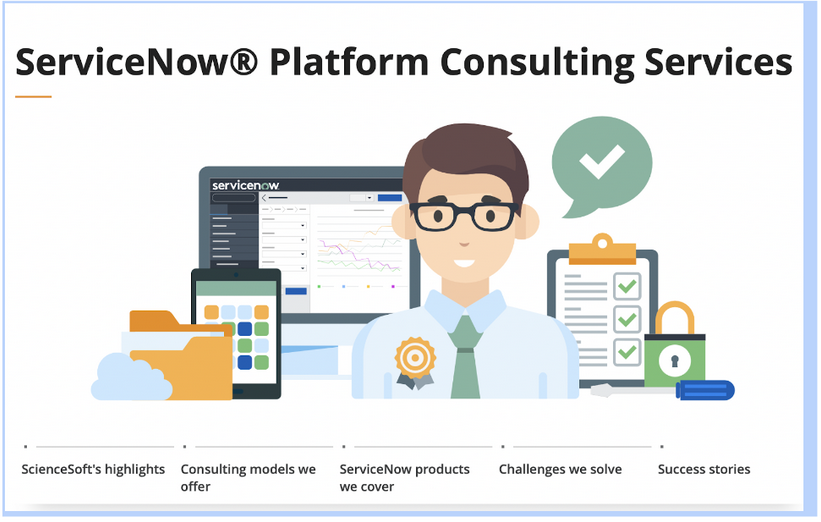
Since 2021, Aiprus Software offers ServiceNow consulting services to help customers overcome disruptions in IT processes, optimize IT support costs, and more.
- Highlights of Our Competencies
ServiceNow certificates in the team, including implementation, application development.
- One-time consultation
If you have encountered a ServiceNow challenge and have no idea how to solve it, we’re always ready to use our ServiceNow savvy to help. After finding a way to address your challenge, we can proceed with its implementation. For instance:
Challenge
Your company has to manage different overlapping Service Level Agreements (SLAs) with different vendors.
Possible solution: We propose to create different workflows, configure the Service Level Management application and integrate your ServiceNow with your vendors’ ITSM solutions. This way, it’ll be easier to control the quality of your services. - Full-cycle implementation of a ServiceNow solution
- ServiceNow implementation with its alignment to your business processes.
- ServiceNow-based custom application development focused on your specific business needs (e.g., applications for integrations, user satisfaction surveys, data import for updating CMDB, Foundation Data, etc.).
- Expansion of the existing ServiceNow functionality (e.g., to cover more ITIL processes).
- Integration of ServiceNow with other systems (Jira, SolarWinds, CMS, ERP, email services and more).
- Migration from legacy ITSM systems to the ServiceNow platform.
- Maintenance and support of your ServiceNow instances.
- Ongoing improvements
Optimizing IT services is not a one-time matter, but a lasting process. In order to improve your IT services more efficiently, we can help you find and eliminate flaws on a constant basis. We do it like this:
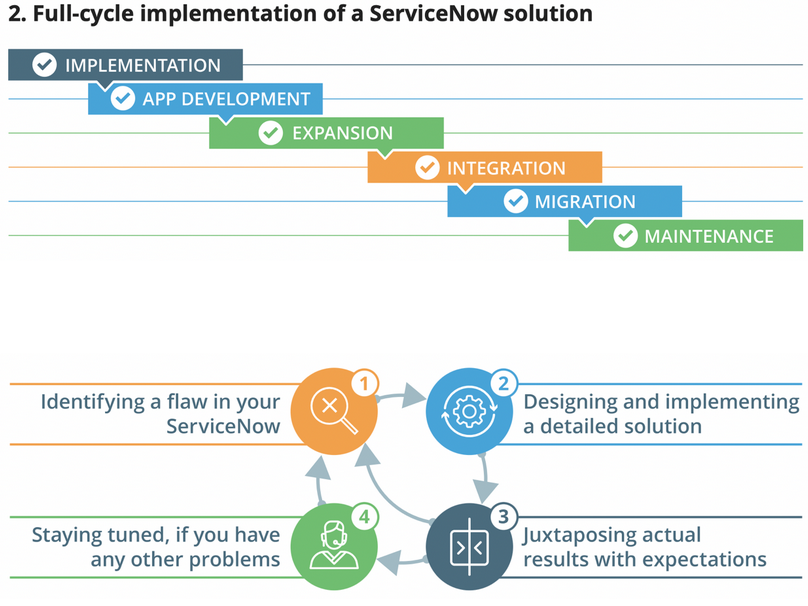
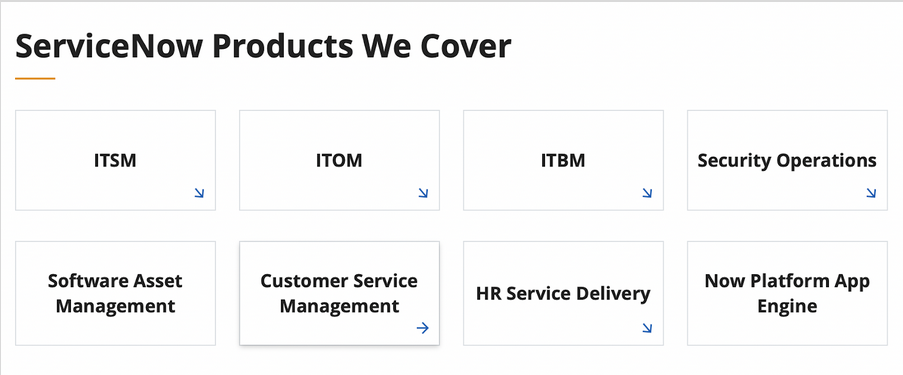
1.3.4 Office 365
Get Value Through Flexibility and Business everywhere
The Productivity Solutions
Real time collaboration, communication and powerful analytics are vital factors in the success of every business. With a wide array of technologies like Exchange Online, SharePoint Online, OneDrive for Business, Skype for Business, Power BI and the most up to date version of Office applications and many more; Office 365 is a highly effective cloud platform that enables your workforce to make full utilization of their productivity, creativity and have the competitive edge over others
- Complete Email and Calendar Solutions
Microsoft's Office 365 suite includes Exchange Online, which is a hosted messaging application that provides organizations with access to the full-featured version of Exchange Server. It includes access to email, calendars, contacts and tasks for any endpoint device. It’s easier than ever to provide your users with the business email they need to stay productive. Automatic patching eliminates the time and effort of maintaining your system. Give your users an In-Place Archive, so they can keep all their important data in one place. And provide them with anywhere access to email, calendar, and contacts on all major browsers and across devices. Integration with Outlook means they’ll enjoy a rich, familiar email experience with offline access. - Collaboration and Documents Management Solution
Microsoft Office 365 also contain SharePoint Online which is a cloud-based service that helps organizations share and collaborate with colleagues, partners, and customers. With SharePoint, you can access internal sites, documents, and other information from anywhere—at the office, at home, or from a mobile device. - Unified Communication and Instant messaging Solution
Microsoft Office 365 has Skype for Business online which is an instant messaging client used with Skype for Business Online. Skype for Business is enterprise software. With office 365 you get to setup your skype for business in minutes and start communicating with colleagues and other Business Partners. - Familiar Office Apps that you already know
Microsoft Office 365 has come With the familiar office apps that you already know and used. Stay up to date with office 365, use the latest version of office all the time. Office 365 also gives you the flexibility of using office apps everywhere on every device thereby staying connected with colleagues at home or office.
1.3.5 MICROSOFT Dynamics
CapabilitiesFutureSoft offers two models of Microsoft CRM implementation:-
- On-Premise
- Online
On-premise Implementation
This is the conventional model of implementation where Microsoft Dynamics CRM Server license and CALs and the hardware required is bought and managed on site by the customer. FutureSoft has done a number of on premise implementation of Microsoft CRM for clients across different industries.
Our experienced consultants would help you get a quick start and fast implementation. The solution would be customized to your specific requirements and would be integrated to your other enterprise systems.
Online Implementation
Microsoft Dynamics CRM Online is an online solution which comes with 99.9% SLA and is completely owned and managed Microsoft. The data and infrastructure of any customer is maintained and managed by Microsoft using its secure data center and the clients need to pay a monthly subscription fee for each user to get access to the Microsoft Dynamics CRM Online service.
Futuresoft has excellent experience in migration of your CRM to CRM online.
- Microsoft CRM Training Services
- Standard Online & On-Premises CRM Training on Application Design Workshop, Customization, Database, Process, Mail Routers and Advanced features
- Customized Refresher training on specific areas
- Supervisors training on best practices
- Basic troubleshooting training to IT Helpdesk
- Customization/Development Services
- Microsoft Dynamics CRM Customization, Custom workflows, CRM Plug-in development, CRM Development Utilities.
- Third-Party Plug-in integration in Microsoft Dynamics CRM.
- Enhancing Dashboards and Role centers.
- Integration of Microsoft Dynamics CRM with various ERPs.
- Report Development.
- Administrative Service
- MS CRM Installation and Role-based security definitions
- Microsoft Dynamics CRM Implementation, Configuration and upgrades
- Microsoft Dynamics CRM maintenance
B. Managed Services
Definition - Managed services is the practice of outsourcing the responsibility for maintaining, and anticipating need for, a range of processes and functions, ostensibly for the purpose of improved operations and reduced budgetary expenditures through the reduction of directly-employed staff.

Why you need this service
1. Centralised account management- Managed service providers offer a single point of contact (or SPOC, in short) to handle the communication between the client and the service providers, regardless of the number of involved countries or projects. -The SPOC is also responsible for maintaining a high level of customer satisfaction and knows the client's business inside out to propose the most effective solutions, so that the client can fully shift their focus on core business and growing operations.
2. Unified process
- We provide Managed service which makes sure that the services provided are unified and all processes are streamlined under one account management and shared communication platform - across multiple juridictions. - With unified processes, administration becomes a lot easier.
3. Simplified global expansion with full compliance
- The managed service global coverage that ensures a stramless expansion of client businesses to any location in the world. These international connections with local vendors ensure the best local knowledge and expertise available while maintaining the unified processes, allowing for a seamless scalability of projects.
4. Business continuity, no matter what
Every business continuty plan with a proper strategy to rapidly respond to any major disruption. The managed service provider can build a resilient internal infrastructure that maintains or quickly restores the business functions, and ensures proper back-up of staff under all circumstances, with support provided accross multiple time zones - if required.
5. Access to cutting-edge technology
- In today's world, where new technological solutions emerge in a blink of an eye, keeping up with the trends and improvements is inevitable to stay competitive. With a singular interface, strict security requirements, fast implementation and necessary automations, managed services can elevate the overall processes of clients at a brink of the costs.
6. Cost-efffective solutions - Considering all the benefits mentioned above, it comes as no surprise that managed services are a lot more cost-effective than running everything in-house. By taking off so much of the burden.
7. Strategic vision far ahead.
- Last but not least, managed service providers are able to take broader, more predictive vision of client operations and look further ahead with a strategic mindset. This allows MSP's to map out the business development of clients with the best and most effective solutions, advice on decision-making and achieve important milestones on the journey to success.
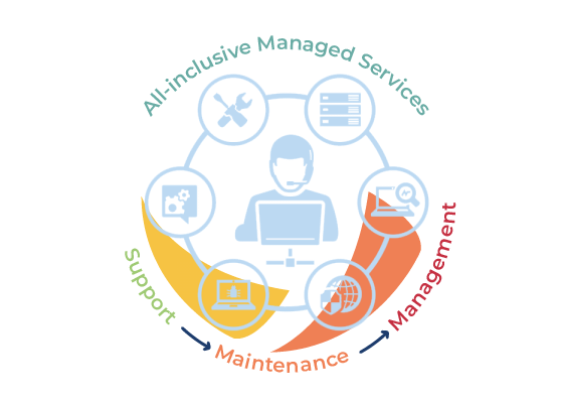

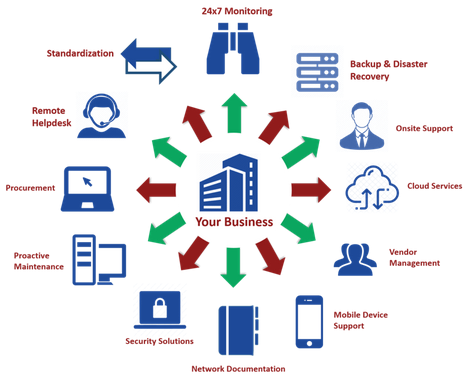

Application development - Digital transformation
a. Definition
Application development is the process of creating software that supports a business function. It consists of tasks relating to each of the seven stages of the application lifecycle. This starts with planning and gathering business requirements; continues with designing, development, testing, and deployment; and ends with the maintenance of your finished software application.
b. What Aiprus do
We specialize in developing applications and software’s for enterprises based on their business needs on latest technology stack(s). Irrespective to the business domain, we provide complete application development services across variety of platforms while using cloud, mobile, and responsive web technologies. We offer full spectrum of software development services, which are scalable, secured, and user friendly; while working with our customers, hand-in-hand. Here, we provide ‘fixed price – fixed scope’ services to our clients and manage all responsibilities related to the engagement. We take ownership and deliver the projects based on agreed timelines. We often take responsibility for maintaining, and anticipating need for, a range of processes and functions in order to improve operations and cut expenses. This model typically offers on-demand services for our customers only for the scope for the work done. These services include:
- Modernization & Platform Migration: We provide application modernization & platform migration services by transforming clients legacy applications on the latest (or upcoming) technology stack. Such modernization leads to: Reduced total cost of ownership; Enhanced Application Capabilities; Decommissioning of undesired components; Enhanced Business Value. We have expertise in executing such modernization projects in our global delivery model; hence reducing the turn-around time and lowering the costs and associated risk.
- Application Development, Testing: Our Application Development services use effective requirement management processes, creative design techniques, domain/business knowledge, scalable design and high-end technological development; while using latest technology trends. We develop custom applications on a variety of platforms as mentioned in our 'Technology Span'.
- Testing & Test Automation: We provide comprehensive application testing services for a variety of applications like: Web, Mobile, API, 3rd Party Product Implementation, Database/Backend, Security. We offer both Manual and Automation testing with a variety of tools & technologies; focused on 'Continuous Testing' throughout sprints. Our testing practices complement our Global Delivery Model and support all principles of modern software development DevOps, CICD, Agile.
- Application Maintenance (24*7 L1, L2, L3 Support): Our expertise in Application Maintenance and Support stand us apart from the competition. Our team is very well qualified in maintaining the applications running on production and non-production environments; while using ITIL standards. We are qualified in troubleshooting, modifying, maintaining and enhancing the applications. Our Services include: 24/7 support model for Level 1, Level 2, Level 3 & PLM support.
| Web UI/UX | CSS, HTML 5, Jquery, Bootstrap, Ajax |
|---|---|
| Mobile Development | iOS, Android, Titanium, Flutter |
| Search Engines | Nutch, Solr, Lucene |
| Front End Development | Javascript, Angular JS, Angular 10, React, PHP |
| Backend Development | MEAN/MERN/Node, Java, Spring Framework, Hibernate, PHP |
| Databases | MYSQL, SQL Server, Oracle, MongoDb, Teradata |
| Application & Web Servers | Cloud Computing & Hosting |
| Cloud Computing & Hosting | Digital Ocean, AWS, Google Cloud, MS Azure |
| Advanced Technologies | AIML |
| Package Implementations | SAP, Oracle Siebel, Salesforce, AWS |
| Operating Systems | Wndows, Linux, Ubuntu, |
Web development is the work involved in developing a website for the Internet or an intranet. Web development can range from developing a simple single static page of plain text to complex web applications, electronic businesses, and social network services. We strive to design and develop websites that attract millions of viewers and effectively convey your business perspective and message to generate the optimum results, without compromising on quality and aesthetics. We offer one of the best website development services.
Website Design has become one of the most basic and growing needs for businesses online. It not only increases ROI but strong online presence. All the websites that we design are compliant with international web design standards
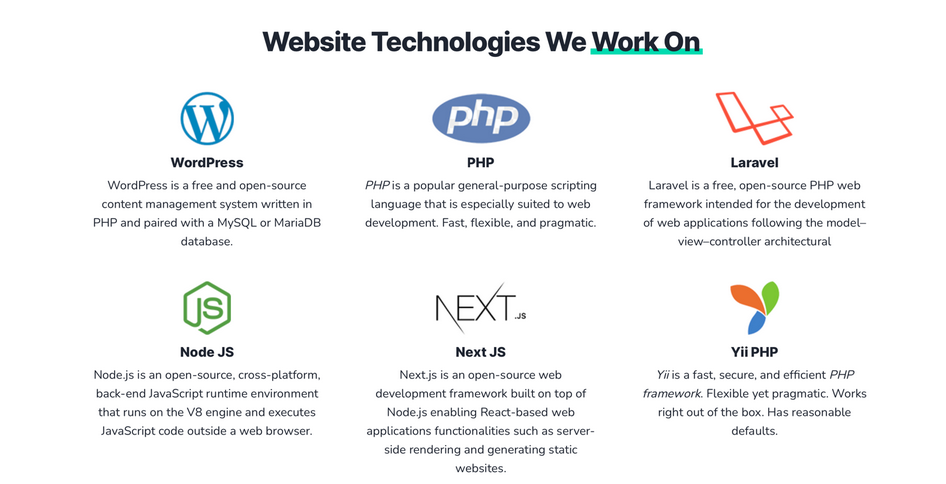
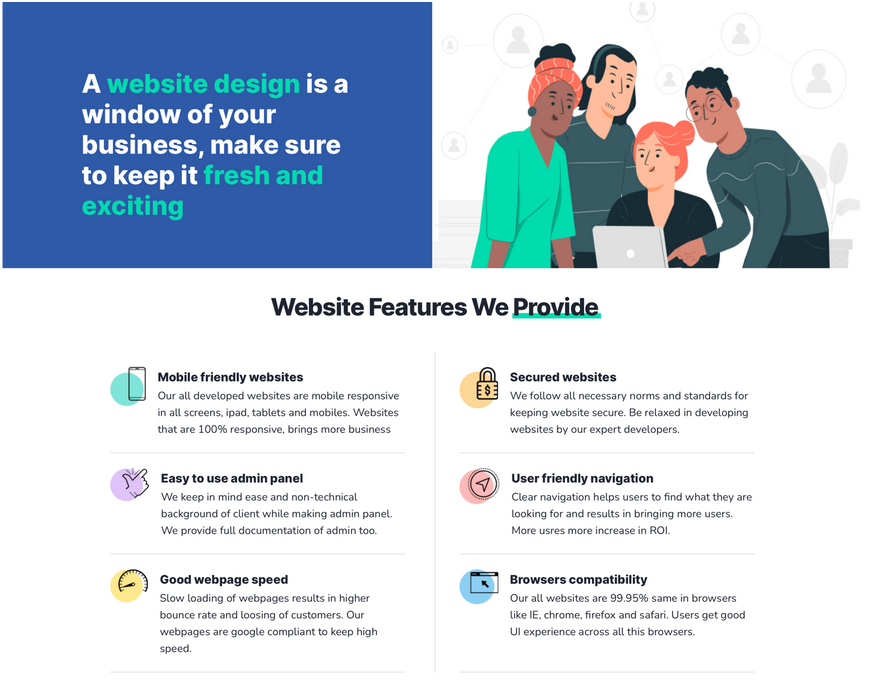
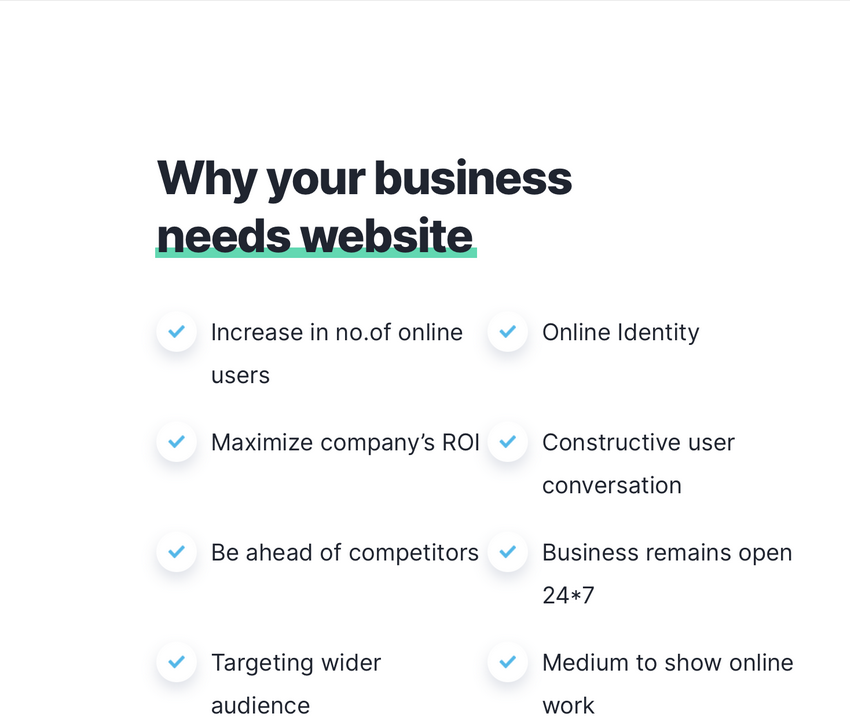
Mobile application development is the process of creating software applications that run on a mobile device, and a typical mobile application utilizes a network connection to work with remote computing resources. Hence, the mobile development process involves creating installable software bundles (code, binaries, assets, etc.) , implementing backend services such as data access with an API, and testing the application on target devices.
Mobile application development is the process of creating software applications that run on a mobile device, and a typical mobile application utilizes a network connection to work with remote computing resources. Hence, the mobile development process involves creating installable software bundles (code, binaries, assets, etc.) , implementing backend services such as data access with an API, and testing the application on target devices.
Mobile application development is the process of creating software applications that run on a mobile device, and a typical mobile application utilizes a network connection to work with remote computing resources. Hence, the mobile development process involves creating installable software bundles (code, binaries, assets, etc.) , implementing backend services such as data access with an API, and testing the application on target devices.
Mobile application development is the process of creating software applications that run on a mobile device, and a typical mobile application utilizes a network connection to work with remote computing resources. Hence, the mobile development process involves creating installable software bundles (code, binaries, assets, etc.) , implementing backend services such as data access with an API, and testing the application on target devices.
Mobile Applications and Device Platforms
There are two dominant platforms in the modern smartphone market. One is the iOS platform from Apple Inc. The iOS platform is the operating system that powers Apple's popular line of iPhone smartphones. The second is Android from Google. The Android operating system is used not only by Google devices but also by many other OEMs to built their own smartphones and other smart devices.
Although there are some similarities between these two platforms when building applications, developing for iOS vs. developing for Android involves using different software development kits (SDKs) and different development toolchain. While Apple uses iOS exclusively for its own devices, Google makes Android available to other companies provided they meet specific requirements such as including certain Google applications on the devices they ship. Developers can build apps for hundreds of millions of devices by targeting both of these platforms.
Alternatives for Building Mobile Apps
There are four major development approaches when building mobile applications
a. Native Mobile Applications
b. Cross-Platform Native Mobile Applications
c. Hybrid Mobile Applications
d. Progressive Web Applications
Each of these approaches for developing mobile applications has its own set of advantages and disadvantages. When choosing the right development approach for their projects, developers consider the desired user experience, the computing resources and native features required by the app, the development budget, time targets, and resources available to maintain the app.
Native Applications:
Native mobile applications are written in the programming language and frameworks provided by the platform owner and running directly on the operating system of the device such as iOS and Android.
Cross-Platform Applications
Cross-platform native mobile applications can be written in variety of different programming languages and frameworks, but they are compiled into a native application running directly on the operating system of the device.
Hybrid-Web Applications
Hybrid mobile applications are built with standard web technologies - such as JavaScript, CSS, and HTML5 - and they are bundled as app installation packages. Contrary to the native apps, hybrid apps work on a 'web container' which provides a browser runtime and a bridge for native device APIs via Apache Cordova.
Progressive Web Applications
PWAs offer an alternative approach to traditional mobile app development by skipping app store delivery and app installations. PWAs are web applications that utilize a set of browser capabilities - such as working offline, running a background process, and adding a link to the device home screen - to provide an 'app like' user experience.
| Pros: | |||
| + Best runtime performance | + Single code base for multiple platforms | + Shared code base between web and mobile apps | + Same app is available both for web and mobile |
| + Direct access to device APIs | + Easy to build and maintain your app | + Using web development skillset for building mobile apps | + No installation required, accessible through a URL |
| Cons: | |||
| - Higher costs when building and maintaining your app | - Dependents on bridges and libraries for native device features | - Lower performance compared to native apps | - Limited support for native device features |
| - Multiple code-bases for each platform | - Performance limitations due to bridging | - Limited support for native device features | - App capabilities depend on the browser in use |
At the highest level, there are four main ways that native apps differ from hybrid apps as illustrated in the following table.
| Native | Hybrid |
| Platform Specific | Cross Platform |
| Compiled Language | Scripting / Compiled |
| Access to Device Hardware | Plugins / Native Modules |
| Platform Frameworks | Web Frameworks |
Why Choose the Hybrid/Cross-platform Approach?
One problem with native mobile application development is that it requires a highly specialized skill set. Although there are large and vibrant developer communities for C and Java -- the language families that are mostly used for native development --, there are fewer developers who are knowledgeable in platform-specific versions of those languages and their respective IDEs. In fact, skilled native app developers are in such demand, that many companies are hard-pressed to hire and retain them on staff, and instead they frequently have to resort to outside 3rd party design and development houses to build their apps for them.
How Hybrid and Cross-platform Frameworks Work?
Hybrid apps allow developers to use web technologies of HTML5/CSS/JavaScript and then encapsulate those web applications in a container that allows the web application to act like a native application on the device. Since hybrid mobile apps are just web apps running on an embedded browser environment, most of the code from a web app can be used to build a mobile app. As rendering and runtime performance of mobile browsers are ever-increasing, hybrid development is a viable alternative for web developers who want to build mobile apps quickly.
Similarly, PWAs are written using traditional web application programming technologies usually including some variant of JavaScript, HTML5, and CSS, and are accessed initially through a browser on the device or computer.
Most cross-platform frameworks such as - React Native and Native Script - provides native components to work with the cross-platform code, while some others such as Flutter and Xamarin compiles cross-platform code to the native code for better performance. The Mobile Application Development Lifecycle
There are two interlinked core components of a mobile application: 1) the mobile application “Front-End” that resides on the mobile device, and 2) the services “Back-End” that supports the mobile front-end.

In the early days of the modern smartphone applications era, mobile applications went through a similar evolution as first websites. At first, the applications and sites where wholly contained within themselves and acted as little more than static advertisements for the brand, company, product, or service.
However, as connectivity and network capabilities improved, the applications became increasingly connected to sources of data and information that lived outside of the app itself, and the apps became increasingly dynamic as they were able to update their UI and content with data received over the network from queries to data sources.
As a result, the mobile front-end applications increasingly rely on and integrated with back-end services which provide data to be consumed through the mobile front-end. Such data can include, for example, product information for e-commerce apps or flight info for travel and reservation apps. For a mobile game, the data may include new levels or challenges and scores or avatars from other players.
How Front-end 'Talks' to the Back-end?
The mobile front-end obtains the data from the back-end via a variety of service calls such as APIs. In some cases, these APIs may be owned and operated by the same entity developing the mobile application. In other cases, the API may be controlled by a third party and access is granted to the mobile application via a commercial arrangement.
For example, a developer may obtain social media or advertising content by making calls to media or advertising company services. In this case, a developer may have to sign a contract in order to obtain credentials and a key that grants access to the API and governs how that developer can use it, how much it will cost, or how frequently it may be called, or how much data can be requested over what time period.
Why Developers Use a Cloud-backend?
For most of the applications, mobile developers are responsible for creating and managing the back-end services for their application. The mobile developer may not be an expert or even particularly skilled in spinning up and running a back-end infrastructure.
In such a case, developers may prefer to take advantage of a cloud services provider -- a backend-as-a-service provider -- that handles all of the drudge work and heavy lifting of managing back-end capabilities, so the developers can focus purely on the features and functionality they are building in their app, without having to worry about scalability, security, and reliability.
The Mobile Application Front-End
The mobile front-end is the visual and interactive part of the application the user experiences. It usually resides on the device, or there is at least an icon representing the app that is visible on the home screen or is pinned in the application catalog of the device. The application can be downloaded from the platform app store, side-loaded directly onto the device, or can be reached through the device’s browser, as in the case for PWAs.
What a Front-end Development Workflow Looks Like?
When a developer says they are a mobile application programmer, they are most often referring to this front-end part of the application, and they are skilled in the languages and technologies that are used to create this front-end application.
Depending on the size of the team producing the app, there may be many different people involved in the design and development of the front-end mobile app. The team size can range from a single developer who does everything associated with building the app, to tens, hundreds, and more people with specialized skills.
For example, there may be dedicated creative/graphics designers who are responsible for creating visual elements of applications like icons, backgrounds, colors, themes and other parts of the app. The team may also have user experience and user interface designs who work on the layout of the components, how they interact with each other and the user. In the case of certain types of games, a team may include motion graphics developers and even engineers who develop engines that govern the physics of how components move in the app, like a car in a racing game.
How Mobile Aps Integrate with the Backend?
Regardless of the size of the team, a critical element of the development effort is building the app logic that is responsible for making network calls to the back-end services, retrieve data and update the data in the back-end systems with new information generated from the app.
These back-end services are typically accessed through a variety of application programming interfaces, most commonly known as APIs. There are different types of APIs, such as REST and GraphQL, and there are also a wide variety of means and styles of accessing them. While some back-end service APIs are available directly to the application through calls in the platform itself, many of the specialized services have to be integrated into the app via a software development kit, commonly known as an SDK. Once the SDK has been added to the app via the development environment, then the application can make use of the APIs defined in the SDK.
How to Interact with the Backend Data?
An example of a back-end service for a mobile front-end could be a database that contains information used in the app. To access the database directly, the mobile developer would have to know the network location of the database, the protocol for accessing the database, the credentials for authenticating and authorizing the data access, and the specific database commands needed to extract the needed data.
Alternatively, the developer can utilize a specialized API when interacting with the database; the developer may only have to know the parameters needed in a method call to get or updated the needed information. In some cases, the mobile developer may develop these APIs themselves or use the API definition provided to them by the owner/operator of the back-end resource.
Typically, a REST API is used to interact with data sources on the cloud, such as a cloud database. A GraphQL API is also another option for developers, as it makes easy to work with backend data in a mobile application. GraphQL provides querying support through a single API endpoint, and a data schema that can be used to build and easily extend data models that are used in the app.
The Mobile Application Back-End
Regardless of what front-end platform or development methodology is being used, delivering high-quality mobile applications that delight and retain users requires reliable back-end services.
Given the critical importance of back-end services for the success of the mobile application, the developers have several important architectural decisions that they must consider. These decisions include which services should they build themselves and which third party services should they leverage, and then should they run and maintain their own services or should they take advantage of 3rd party services.
The answer is increasingly clear; to improve developer productivity and efficiency, mobile app programmers should only build their own services if they are highly specific to the domain of the application and embody unique intellectual property. Also, even for the services they build themselves, they should almost always leverage cloud-based services to build and maintain their backend infrastructure.
Key Mobile Application Services
There are hundreds of cloud and 3rd party services that mobile application developers can leverage to speed up the development and delivery of their applications. However, it’s unlikely that a developer is going to be able to become an expert in each of these individual services.
Instead, the mobile developers should look for a development environment that makes it easier for them to integrate, use, and consume the most commonly required capabilities into their application quickly and easily, while still preserving the freedom to take advantage of the many individual services available.
- Essential
- User Sign-up/Sign-in and Management
- Social login (Facebook sign-in, Twitter sign-in, etc.)
- Analytics and User Engagement
- Push Notifications
- Real Device Testing
- Data Services
- Cloud Storage
- Real-time and Offline Data
- Application Logic/Cloud Functions
- Conversational Bots
- Image and Video Recognition
- Speech Recognition
